Understanding the unique challenges of navigating New York’s bustling streets is essential before you get behind the wheel. When driving in the Empire State, you must adapt to heavy traffic conditions and follow strict traffic regulations to ensure your safety and avoid penalties. Your journey through New York’s roads requires knowledge of specific rules, from the 25 mph speed limit in urban areas to the complete ban on handheld devices while driving. Whether you explore Manhattan’s grid system or venture into the scenic upstate regions, understanding local driving laws will help you confidently navigate and stay safe on New York’s diverse roadways.
Essential Driving Rules
The fundamental driving regulations in New York require your constant attention to maintain safety on the road. You must always drive on the right side, keep a safe following distance, and use turn signals when changing lanes. Your vehicle must have working headlights, taillights, and brake lights. Seat belts are mandatory for all occupants, and children under eight must use appropriate restraint systems.
Speed Limits and Traffic Signals
Speed limits in New York vary by location: 25 mph is the default in New York City unless otherwise posted, while highways typically allow 55-65 mph. You must come to a complete stop at red lights and stop signs. Right turns on red are prohibited in NYC unless permitted explicitly by posted signs. Traffic cameras actively monitor intersections and school zones.
Right-of-Way and Pedestrian Laws
Besides standard traffic rules, you must always yield to pedestrians in crosswalks, whether marked or unmarked. Your responsibility includes stopping for school buses displaying flashing red lights and yielding to emergency vehicles. Failing to yield to pedestrians can result in heavy fines and points on your license.
Also, you must exercise extra caution in school zones and residential areas where pedestrian traffic is high. Pedestrians have the right-of-way when crossing with the signal, and you must remain stopped until they have entirely crossed. Your vehicle must not block crosswalks or intersections, even temporarily.
Vehicle Requirements
Your vehicle must meet specific state requirements even before you hit New York’s bustling streets. You must maintain your car in proper working condition, from functional headlights to properly inflated tires. The New York Department of Motor Vehicles (DMV) requires annual safety inspections for all registered vehicles to ensure road safety.
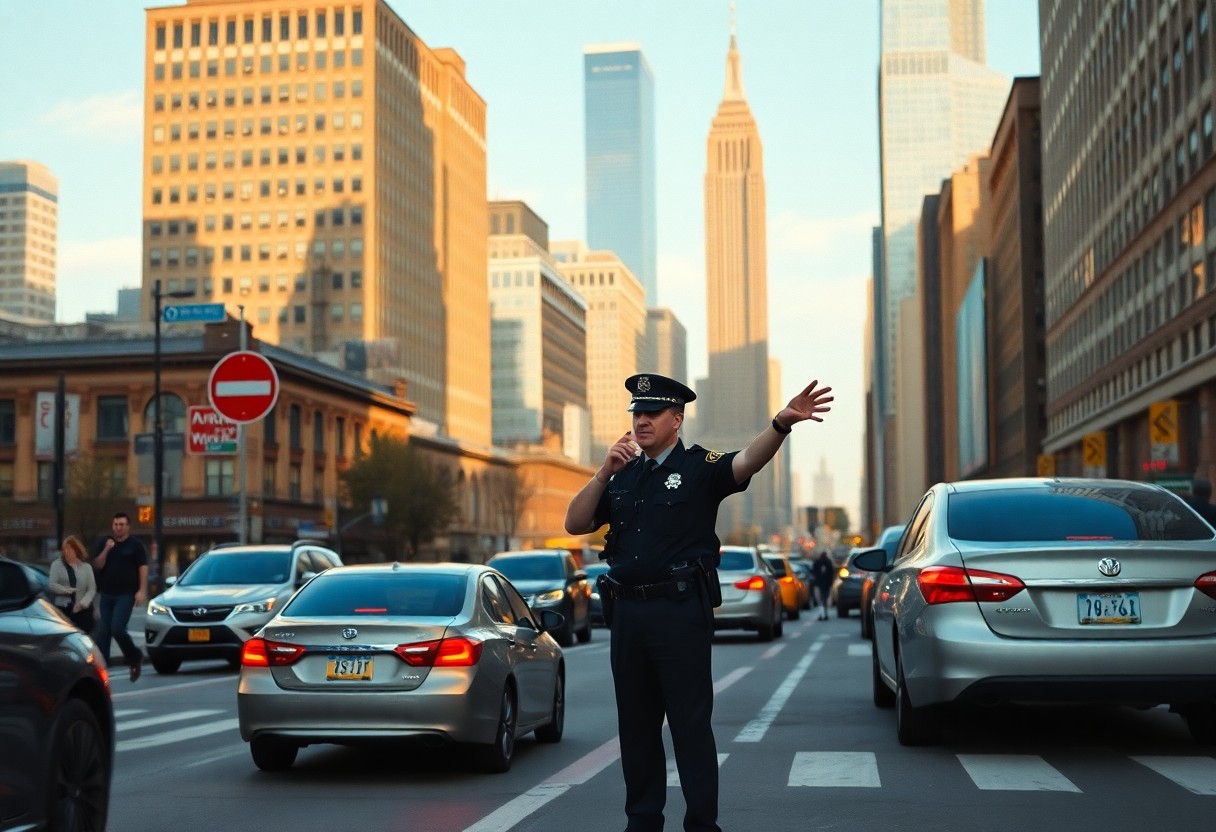
Registration and Insurance
Behind every legal vehicle in New York lies proper documentation. You must carry minimum liability insurance coverage of $25,000/$50,000 for bodily injury and $10,000 for property damage. Your registration must be current, and you need to display valid inspection stickers on your windshield. Failure to maintain these requirements can result in hefty fines and license suspension.
Safety Equipment Standards
Registration isn’t complete without meeting New York’s safety equipment standards. Your vehicle must have working headlights, brake lights, turn signals, and windshield wipers. The state also requires functional seat belts, mirrors, and a horn. These requirements help ensure your safety and the safety of others on the road.
New York’s equipment regulations extend beyond basic requirements. Your vehicle must maintain proper emission standards and pass regular smog checks. The state requires working defrosters, adequate tire tread depth, and properly functioning brakes. You must also have emergency equipment like hazard lights and reflectors for unexpected situations.
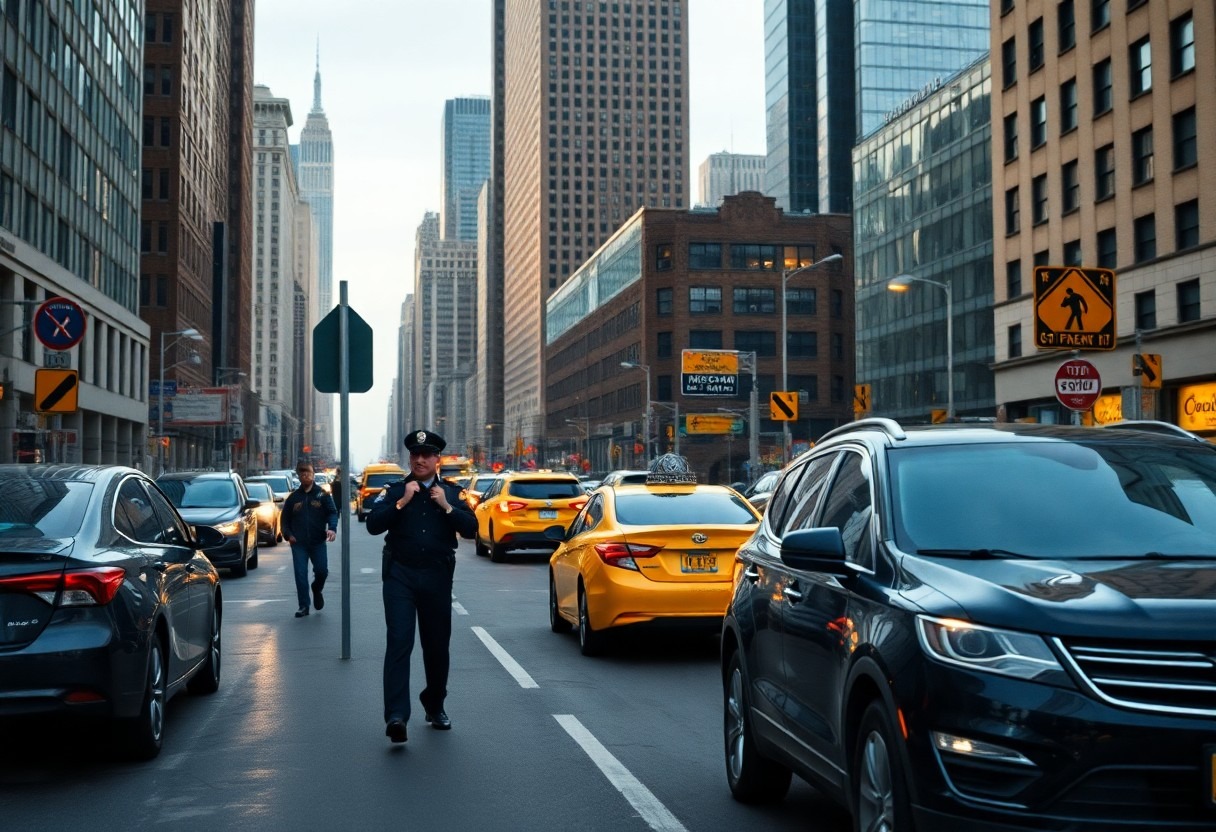
Special Zones and Restrictions
Some areas in New York require extra caution and specific compliance with local regulations. You’ll encounter restricted zones, including school areas, construction sites, and residential districts. Each zone has its own set of rules, and violations can result in hefty fines ranging from $90 to $600, depending on the severity of the offense.
School and Work Zones
The most critical areas for your attention are school and work zones. You must reduce your speed to 15-20 mph in school zones during school hours. Work zones require following posted speed limits and maintaining a safe distance from construction workers. Fines are doubled in these areas, and your safety awareness helps protect vulnerable pedestrians and workers.
Parking Regulations
Below are the vital parking rules you need to follow in New York. Alternate-side parking regulations apply in most areas, and you must observe posted signs indicating specific days and times. Metered parking zones are found throughout the city, with rates varying by location and time of day.
Further details about parking include strict enforcement of fire hydrant clearance (minimum 15 feet) and no-standing zones near intersections. You must pay attention to residential permit requirements in specific neighborhoods. Parking violations can result in tickets ranging from $65 to $115, and your vehicle may be towed if you block essential services or create safety hazards.
License Requirements
Your valid driver’s license is vital for legal driving in New York. To operate a vehicle, you must be at least 16 years old and hold either a New York State driver’s license or a valid out-of-state license. First-time drivers must complete a state-approved driver education course and pass written and road tests.
New York Driver’s License Classes
One of the most critical aspects of driving in New York is understanding license classifications. Class D is the standard license for passenger vehicles, while commercial permits (CDL) range from Class A to C. Each class has specific privileges and restrictions that determine the types of cars you can legally operate.
Out-of-State License Policies
Out-of-state licenses remain valid for up to 30 days after residency in New York. If you’re visiting as a tourist or temporary resident, you can drive with your home state’s license. International visitors must carry a valid foreign license and an International Driving Permit.
Further information about out-of-state licenses includes specific requirements for military personnel and their families, who may maintain their home-state licenses while stationed in New York. If you become a permanent resident, you must exchange your out-of-state license within 30 days by visiting a DMV office and passing a written test.
Safety Measures
To ensure your safety on New York roads, you must follow strict traffic regulations and maintain constant awareness of your surroundings. Your vehicle must have functional safety features, including working headlights, taillights, turn signals, and properly inflated tires. Regular vehicle maintenance is crucial for safe driving in New York’s demanding traffic conditions.
Child Safety Requirements
Any child under eight years old must be secured in an appropriate child restraint system. Your children under two must ride in a rear-facing car seat, while those between two and four need a forward-facing car seat. Children aged four to eight should use booster seats. Violations of these requirements can result in fines of up to $100 and three penalty points on your license.
Seatbelt and Mobile Device Laws
Measures to protect you and your passengers include mandatory seatbelt use for all vehicle occupants. You must ensure everyone buckles up, regardless of their seating position. The use of handheld devices while driving is strictly prohibited, and fines range from $50 to $450, depending on repeat offenses.
Even a momentary distraction can lead to severe consequences on New York roads. Your first violation of mobile device laws results in five driver violation points, and subsequent offenses can lead to license suspension. Hands-free devices are permitted, but you should minimize their use to maintain focus on driving.
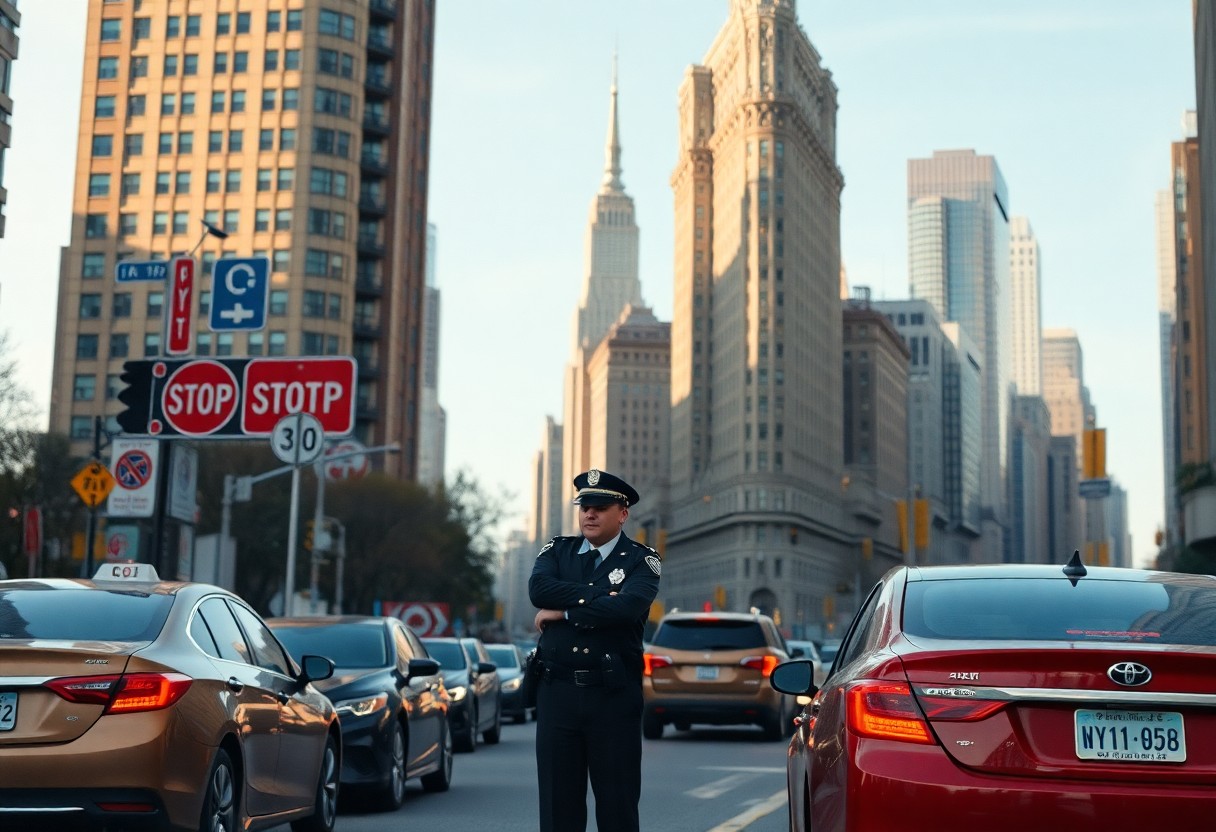
Traffic Violations
Once again, navigating through New York’s traffic laws requires your constant attention. The city enforces strict compliance with traffic regulations, and violations can result in severe consequences. Your awareness of these rules isn’t just about avoiding tickets – it’s about maintaining road safety for everyone.
Common Infractions
On New York streets, the most frequent violations include speeding (particularly in school zones), running red lights, illegal mobile phone use, and improper turns. Your chances of encountering enforcement are high, as the city employs traditional police patrols and automated enforcement systems. Recent data shows that speed cameras alone issued over 4 million violations in 2022.
Penalties and Fines
At the first offense, your fines can range from $50 to $1,000 depending on the violation. The New York DMV operates on a point system, where accumulating 11 points within 18 months can lead to license suspension. Your insurance rates may also increase significantly after violations.
It’s worth noting that New York employs a graduated penalty system, meaning repeat offenses result in progressively severe consequences. Your violations can stay on your driving record for up to four years, potentially affecting your insurance rates and driving privileges. The state’s zero-tolerance policy for DUI offenses can result in immediate license suspension and mandatory court appearances.
To wrap up
You can see above that driving in New York demands your full attention and adherence to specific rules. Your safety depends on following speed limits, yielding to pedestrians, and maintaining proper child restraints. Through RentaCar24.org, you can access well-maintained vehicles that meet all safety requirements. By staying informed about local traffic laws and keeping these guidelines in mind, you’ll confidently navigate New York’s busy streets. Understanding these regulations will help ensure a smooth, safe driving experience in the Empire State.

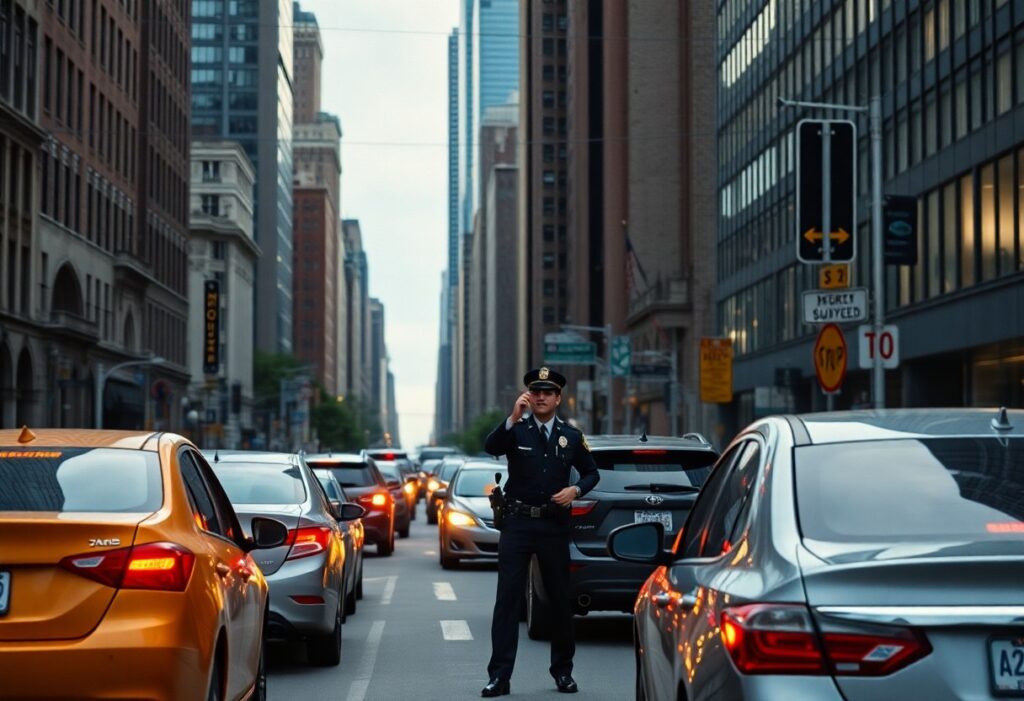

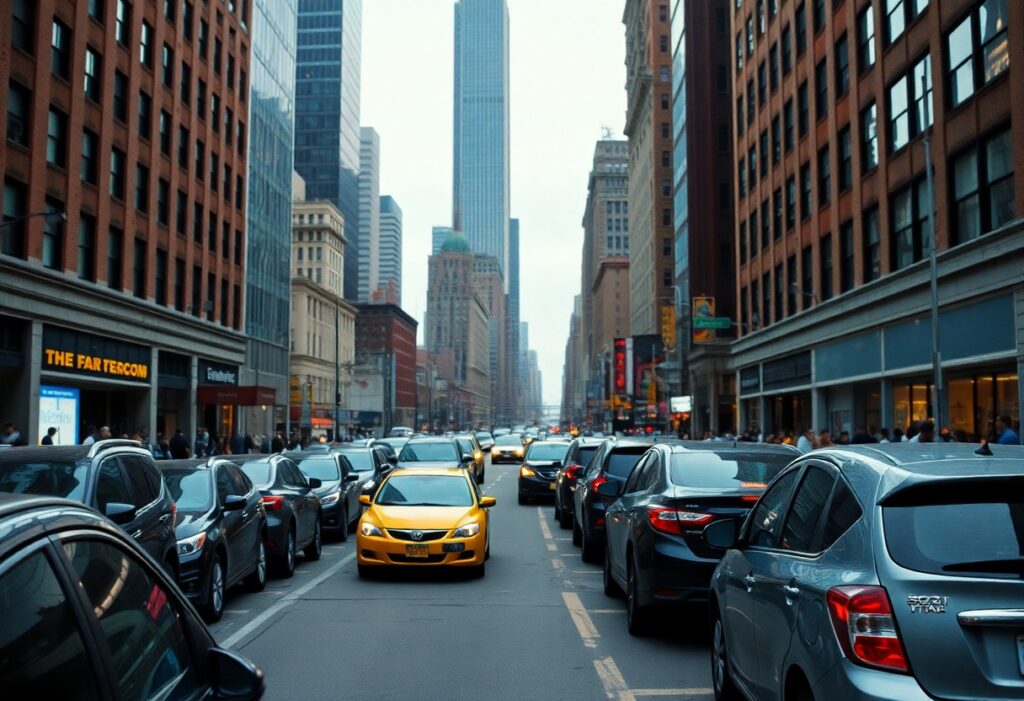

Your analysis of the driving landscape in New York City is quite insightful, particularly regarding the unique challenges posed by its bustling streets. Having recently navigated the chaos of Manhattan myself, I can attest to the complexity of adapting to such an environment. The strict traffic regulations you mentioned are not just there for enforcement; they truly serve as essential guidelines for ensuring the safety of both drivers and pedestrians.
Navigating Manhattan’s streets can feel like stepping into a live-action puzzle, right? The blend of honking horns, throngs of pedestrians, and cyclists zipping past creates a real test of adaptability. What’s fascinating is how those strict traffic regulations shape not just order, but also a sense of community. They encourage drivers to remain alert and considerate, fostering an environment where everyone—drivers, pedestrians, and cyclists—shares responsibility for each other’s safety.
You’ve captured an essential aspect of navigating NYC’s tableau of traffic—the inherent chaos that often feels more like a dance than a commute. The strict regulations are a double-edged sword; they aim for safety but can sometimes feel overly complicated for those on the ground. It’s fascinating how what seems like mere rules are, in reality, unwritten codes that locals learn to navigate with instinct.
You’ve really captured that chaotic ballet of NYC traffic in a way that resonates with anyone who’s spent time navigating the streets. It’s true; sometimes it feels like you’re part of a living, breathing system where every cyclist, pedestrian, and driver is playing their own role in a grand performance. Those unwritten codes definitely come into play. I remember when I first started commuting in the city—there was a steep learning curve. The more intuitive cues, like knowing when to merge or how quickly to flow with the crowd, really do feel instinctual after a while.
You’ve articulated that chaotic ballet of NYC traffic so well. It really does feel like a performance at times, doesn’t it? I remember when I first started commuting too; it was like being thrown into the deep end of a pool. The unwritten codes you mentioned are fascinating—it’s like a dance that everyone knows the steps to, but we all learn them in our own way.
You’ve really hit the nail on the head with that description of NYC traffic as a chaotic ballet. It’s fascinating how, over time, we start to read the subtle cues that guide us through the dance of the streets. I remember when I first biked through the city—it felt like stepping into the deep end without knowing how to swim. The unwritten codes you mentioned, like sensing when to slow down or when to push forward, really come into play as we become more attuned to the ebb and flow of the city.
Your experience of biking through NYC really captures the essence of what it’s like to navigate the city. That initial plunge into the chaos can feel overwhelming, but it also sparks something fascinating, doesn’t it? Learning how to read those subtle cues, like when to pull back or push ahead, becomes almost instinctual.
You’ve really touched on something interesting about that instinctual understanding of the city’s rhythm. It does feel like a dance, doesn’t it? I remember those first few weeks when I was cycling through the chaotic streets; every intersection felt like a mini crisis waiting to happen. But as the weeks turned into months, it became a sort of second nature—like learning a new language.
You’ve captured a key aspect of city life perfectly. The initial chaos can feel overwhelming, especially when you’re navigating a bike through the hustle and bustle. But that transition from panic to familiarity is fascinating. It says a lot about our ability to adapt. It becomes less about mastering routes and more about syncing with the surrounding energy.
It really does feel like a dance. There’s something captivating about how every street, every cyclist, and even every pedestrian contributes to this living choreography of the city. I remember those early days too; the adrenaline was almost intoxicating as I navigated the bustling intersections, each one feeling like a test of instinct. It’s funny how our bodies adapt, isn’t it? It’s like our muscles and minds begin to sync with the city’s pulse over time, making those once-daunting rides feel almost meditative.
I totally get what you mean about that feeling of being in sync with the city. It’s like you start to notice the little rhythms—the way a cyclist might dart in and out, how pedestrians seem to flow around each other, and even how the streets have their own unique vibe at different times of the day. There’s almost a language to it, isn’t there? Every turn and stop feels like a conversation with the environment.
I really resonate with what you said about that feeling of being in sync with the city. There’s definitely a certain rhythm that emerges when you start to take notice of those little details. It’s fascinating how cyclists, pedestrians, and even the occasional street performer contribute to this living tapestry.
It’s so true how that chaotic ballet of NYC traffic can feel like an intricate dance where everyone is following these unspoken rules. It’s almost like a rite of passage to navigate the city, right? I remember my own steep learning curve; it’s almost like you have to develop a sixth sense for the rhythms of the streets.
Navigating the streets of Manhattan can certainly feel like stepping into a very different world, can’t it? Your firsthand experience captures that chaotic energy perfectly. There’s this rhythm to it all—cars weaving in and out, pedestrians darting across, and the ever-present hum of the city that seems to push everyone forward, each with their own destination in mind.
Navigating Manhattan can really feel like diving into a whirlwind, can’t it? The energy is palpable, and every corner seems to have its own rhythm. You’re spot on about those traffic regulations—they might feel limiting at times, but they play a crucial role in managing that energetic chaos. I’ve found that those rules not only enhance safety but also encourage a certain etiquette on the road, which is key in a city where everyone is in a rush.
Navigating New York’s streets really does require a unique set of skills and awareness. It’s fascinating how the hustle and bustle of city life can affect not only driving habits but also our overall experience of the city. I remember my first time driving in Manhattan—what a challenge! The traffic, the pedestrians, the cyclists, and the ever-present yellow cabs all seemed to have their own rhythm.
You’ve hit the nail on the head about the chaos of driving in Manhattan. It’s like a dance, right? Everyone has their own steps—pedestrians darting in and out, cyclists weaving through traffic, and those iconic yellow cabs zooming around with their own sense of urgency. I remember my first drive through the city too. It felt like an obstacle course where you had to predict what everyone else was going to do.
Navigating the streets of New York can indeed feel like a daunting task at times, especially with its blend of frenetic energy and strict regulations. Having driven through the city several times, I wholeheartedly resonate with your emphasis on understanding local driving laws. It’s more than just a checklist for avoiding tickets—it’s about cultivating a mindset that prioritizes safety and awareness in such a sprawling urban landscape.
I completely get where you’re coming from. The pace of New York can be overwhelming, especially if you’re not familiar with the layout and the driving customs. What’s interesting is how driving in the city can really reflect broader themes of urban life; it’s like a microcosm of modern society. There’s this constant push and pull between the rush of daily living and the need for safety and mindfulness.
You’ve hit the nail on the head. New York driving feels like a high-stakes game of chess where the pieces are swerving between honking taxis and steadfast cyclists. It’s like a ballet, but with more yelling and significantly fewer tutus. The rush creates its own rhythm, but how quickly we forget that it’s all connected—a seamless dance of human experience.
You hit the nail on the head! It’s like navigating a circus while riding a unicycle—full of chaos but oddly fascinating. The driving customs? A dance of instinct and nerve, while pedestrians look like they’re auditioning for a part in a superhero movie with all the dodging they do.
Navigating the chaos of urban driving really does feel like an acrobatic performance, doesn’t it? It’s fascinating how instinct and adaptability play such a huge role in that dance. In many ways, it mirrors the unpredictability of daily life itself—whether it’s in city streets or our personal routines.
You’ve put your finger on something really intriguing. New York isn’t just a city; it’s a living organism, constantly buzzing with life, each element contributing to its unique rhythm. When you’re behind the wheel navigating through the streets, you start to notice that every honk and every stoplight can tell you a story about the people around you.
Your insights into the specific driving regulations in New York are crucial, especially for those unfamiliar with the city’s chaotic environment. The strict laws regarding speed limits and handheld devices highlight the state’s commitment to road safety.
I completely agree that understanding the specific driving regulations in New York is essential, especially when navigating its unique urban landscape. The strict laws about speed limits and handheld devices aren’t just about following rules; they reflect a broader commitment to protecting public safety in a place that’s often buzzing with activity.
You bring up a great point about public safety. It’s interesting how the hustle and bustle of city life can sometimes make people forget that the rules are really there for everyone’s protection. With so many pedestrians and cyclists in the mix, those speed limits and restrictions on devices play a huge role in keeping things running smoothly.
You make a really good point about those regulations reflecting a commitment to public safety. Living in such a dynamic environment, like New York City, definitely adds complexity to driving. The combination of pedestrians, cyclists, and constant construction makes it essential to stay alert and informed.
You’ve raised an important point about the driving regulations in New York, particularly regarding how they serve a broader purpose. The city’s streets can feel chaotic, with pedestrians, cyclists, and vehicles all competing for space. This bustling dynamic makes adherence to laws like speed limits and restrictions on handheld device use crucial not only for individual drivers but for everyone around them.
You’ve touched on a key aspect of urban life that often gets overlooked. With so many people moving through the city—whether on foot, bike, or in a car—it really does require a collective effort to keep everyone safe. The chaotic energy we love about New York can easily turn dangerous if we’re not all on the same page about the rules of the road.
You’ve hit on something that many people overlook when they think about driving regulations. The streets of New York are a living, breathing mix of hustle and bustle, where each faction—pedestrians, cyclists, and drivers—plays a unique role in keeping the system moving, albeit sometimes chaotically.
It’s great to hear that you found the insights helpful. Navigating New York can feel like a real challenge, especially with its mix of pedestrians, cyclists, and those iconic yellow cabs weaving in and out. The strict laws about speed limits and handheld devices really reflect how important it is to keep everyone safe, especially in such a bustling city.
I really appreciate this breakdown of the driving landscape in New York. Having spent a fair amount of time driving in and around the city, I can attest to how critical it is to be aware of the specific challenges that come with it. The traffic can be maddening, especially during rush hour. I always find myself planning my travel times around it. I remember one time I underestimated the congestion while heading to a meeting in Midtown. What should have been a 20-minute drive turned into a near hour-long ordeal. It really highlights the importance of not just knowing the rules of the road but also planning ahead.
It’s interesting to hear your experience navigating through the labyrinth of New York traffic. You’re touching on a point that anyone who’s driven in the city knows too well: the unpredictability that can turn a straightforward trip into a marathon. Midtown is its own special beast during peak hours. It brings to mind how essential it is to not only be aware of traffic conditions but also to have a mental map of alternative routes and, dare I say, patience.
It’s refreshing to hear about your firsthand experiences navigating the chaotic streets of New York. Your mention of planning around traffic really resonates. The city has its own rhythm that can be tough to get in sync with. Those rush hour surges can feel less like a commute and more like an endurance test some days.
Your exploration of driving in New York highlights not only the practical regulations but also the underlying complexities that come from maneuvering through such an energetic urban landscape. Having lived in New York City for several years, I can personally attest to the unique challenges drivers face—particularly the overwhelming combination of heavy traffic, ambitious cyclists, and unpredictable pedestrians.
Navigating New York’s chaotic streets truly is an art form! I remember my first time driving in Manhattan; it felt like an exhilarating yet overwhelming puzzle with all the honking and flashing lights. The 25 mph speed limit might seem slow, but it makes total sense considering the urban density. Adapting to that pace and the constant need to stay vigilant transformed my driving skills in ways I never expected.
Navigating New York City’s streets can indeed feel like an overwhelming undertaking for many, especially for those who aren’t familiar with its unique rhythms and rules. As you highlighted, adapting to the hustle and bustle is crucial, but so is understanding the underlying cultural mindset that influences driving behaviors in such a dynamic urban environment.
Navigating the complexities of New York’s roads is indeed an endeavor that requires both patience and preparation. Having spent some time driving through the bustling streets of Manhattan and further afield into upstate New York, I’ve found that the unique driving culture here can be both exhilarating and daunting. The contrast in driving experiences between urban areas and the quieter, more scenic routes is striking, and it often underscores the importance of adapting one’s approach to each environment.